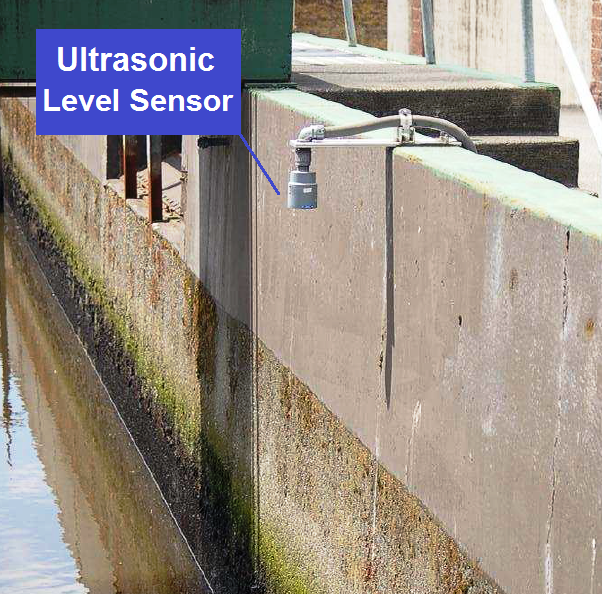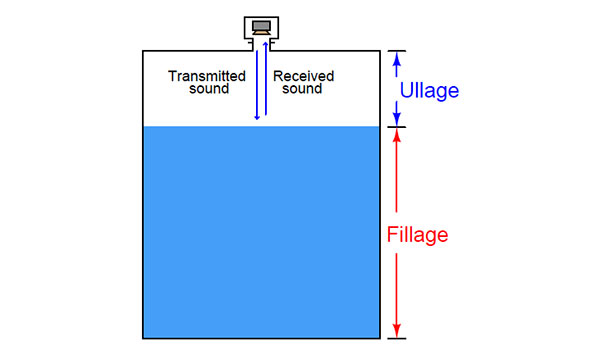Ultrasonic level gauge
Ultrasonic surface instruments measure the distance from the surface transmitter (located at some points above) to the material surface of the process below which it is reflected using sound waves. The frequency of these waves is beyond the range of human hearing, hence they are called ultrasonic. The flight time for a sound pulse indicates this distance and is interpreted by the transmitter as the process level. These surface transmitters may produce a signal commensurate with the fullness of the tank (filling) or the amount of empty space left on top of a tank (output).
Surface transmitter
Fluid height measurement
Ullage is the natural state for measuring this type of surface instrument, because the wave flight time is a direct function of the amount of space between the liquid surface and the top of the vessel. The total height of the tank will always be the amount of filling and overeating. If the ultrasonic level transmitter is programmed with the overall height of the vessel, it may calculate the filling by simple subtraction:
Fillage = Total height − Ullage
If a sound wave experiences a sudden change in the speed of sound of a material, some of the energy of that wave is reflected as another wave in the opposite direction. In other words, when you encounter a substance with a different speed of sound, the wave will “sound”. This is the basis of all ultrasonic devices. Therefore, in order for an ultrasonic surface transmitter to be reliable, the difference in sound speed at the interface between the liquid and the gas must be large. Liquid-gas interfaces almost always show large differences in their sound speeds, and so it is very easy to detect using ultrasonic waves. Liquids with a heavy layer are more difficult than the floating floor above, because the floor is denser than the liquid, but significantly denser than the gas above
.


If the ultrasonic transducer is rough enough and the process vessel is sufficiently free of sludge and other sound damping materials that collect at the end of the vessel, the transducer may be installed at the bottom of the vessel, removing sound waves from the liquid surface. Slowly Itself instead of steam space. As mentioned earlier, any significant difference in sound speed between the two materials is sufficient to reflect the sound wave. In this case, it does not matter what the sound wave of the incident is initially broadcast from:
Ullage = Total height − Fillage
Calibration of an ultrasonic surface transmitter
As mentioned earlier, the calibration of an ultrasonic level transmitter depends on the audio speed through the media between the converter and the interface. For high-level converters, this speed of sound is through air (or steam) on the liquid, because it is the medium through which the incident and the time of motion of the reflected wave are measured. For low-level converters, this is the speed of sound through the liquid. Either way, to ensure good accuracy, you need to make sure that the speed of sound through the “timely” travel path remains reasonably constant (or otherwise changes the speed of sound through that medium using Compensates temperature or pressure measurement (compensating algorithm). Ultrasonic surface transmitters have the advantage of being able to measure the height of solids such as powders and grains stored in arteries, not just liquids. Again, the basic criterion for distinguishing the surface of a material is that the speed of sound through the high and low materials must be different (the greater the difference, the stronger the echo). A unique problem for measuring solids is the ability to specify uneven material profiles. The classic problem when measuring the level of a powder or granule in a container is the helical angle created by the material at a point in the vessel:

Rose Calibration Company in Melbourne, Australia with over ten years of experience provides all calibration, maintenance, and repair services throughout Australia. If you live in Sydney, Melbourne, Adelaide, Perth, Geelong, and Brisbane, you can receive your quote in less than two hours by fill-up the form via the “Booking” link.


